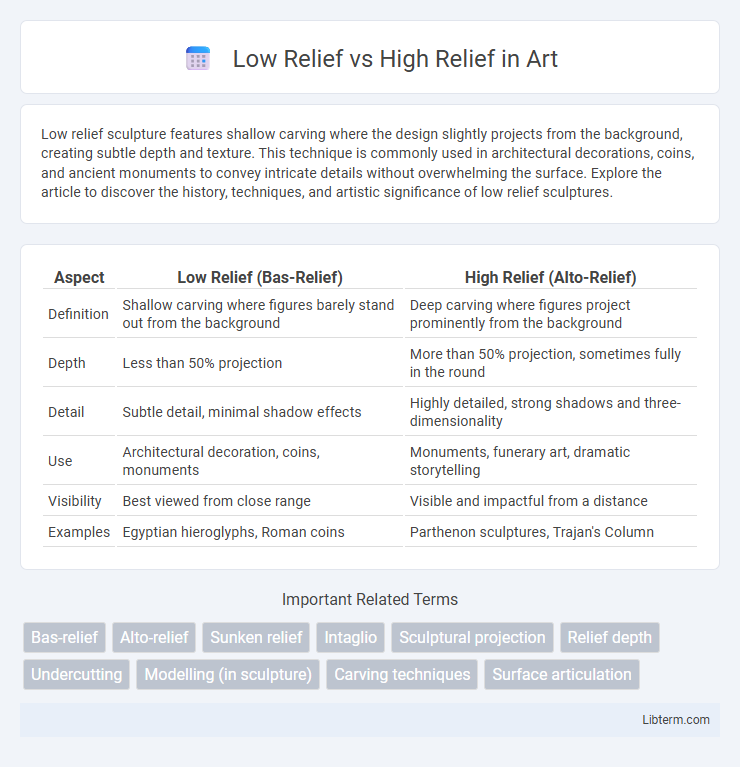Low relief sculpture features shallow carving where the design slightly projects from the background, creating subtle depth and texture. This technique is commonly used in architectural decorations, coins, and ancient monuments to convey intricate details without overwhelming the surface. Explore the article to discover the history, techniques, and artistic significance of low relief sculptures.
Table of Comparison
| Aspect | Low Relief (Bas-Relief) | High Relief (Alto-Relief) |
|---|---|---|
| Definition | Shallow carving where figures barely stand out from the background | Deep carving where figures project prominently from the background |
| Depth | Less than 50% projection | More than 50% projection, sometimes fully in the round |
| Detail | Subtle detail, minimal shadow effects | Highly detailed, strong shadows and three-dimensionality |
| Use | Architectural decoration, coins, monuments | Monuments, funerary art, dramatic storytelling |
| Visibility | Best viewed from close range | Visible and impactful from a distance |
| Examples | Egyptian hieroglyphs, Roman coins | Parthenon sculptures, Trajan's Column |
Understanding Low Relief and High Relief
Low relief (bas-relief) features shallow carving where the image slightly projects from the background, allowing light to cast subtle shadows that emphasize fine details. High relief (alto-relief) involves deeper carving with elements that stand out prominently, often extending more than halfway from the background, creating dramatic depth and pronounced contrasts. Understanding these differences is crucial for art historians and sculptors in analyzing the spatial dynamics and visual impact of relief sculptures.
Definition of Low Relief Sculpture
Low relief sculpture, also known as bas-relief, is a form of sculpting where the figures are slightly raised from the background, creating a subtle depth and minimal projection. This technique contrasts with high relief sculpture, where elements stand out more prominently and may even be fully detached from the background. Low relief is commonly used in architectural decorations, coins, and medals due to its delicate detail and shallow carving.
Characteristics of High Relief Sculpture
High relief sculpture features deeply carved elements that project significantly from the background, often creating dramatic shadows and a strong sense of depth. The figures in high relief typically stand out by more than half of their full depth, sometimes nearly detaching from the background surface. This style allows for intricate detailing and dynamic compositions, making the artwork appear more lifelike and three-dimensional.
Historical Contexts of Relief Art
Low relief, or bas-relief, has been widely used in ancient Egyptian and Mesopotamian art to depict figures with shallow depth, allowing intricate details without deep shadows. High relief, featuring more pronounced depth and three-dimensionality, gained prominence in classical Greek and Roman art, emphasizing dramatic contrasts and lifelike forms. These varying relief techniques reflect cultural priorities, with low relief suited for narrative storytelling on monuments and high relief employed to evoke emotional intensity in sculptures.
Techniques Used in Low Relief
Low relief, also known as bas-relief, involves shallow carving where the sculpted elements slightly project from the background, creating subtle shadows and depth. Techniques used in low relief include incising, chiseling, and slight undercutting to define details and textures without fully detaching the figures from the substrate. These methods allow for intricate, delicate designs often seen in coins, architectural friezes, and ancient panels.
Methods for Creating High Relief
High relief sculpture involves carving figures that project significantly from the background, often more than half their depth. Techniques for creating high relief include subtractive methods such as chiseling deeper into stone or wood to enhance dimensionality, and additive methods like modeling clay or plaster to build up forms before casting. Mastery of depth gradation and undercutting ensures dramatic shadows and a dynamic three-dimensional effect in high relief artworks.
Artistic Purposes of Low vs High Relief
Low relief sculpture, known as bas-relief, offers subtle depth and delicate shading ideal for intricate narrative scenes and architectural decorations, allowing artists to emphasize fine details while maintaining a flat background. High relief, or alto-relievo, creates dramatic, prominent forms that project significantly from the surface, enhancing visual impact and dynamic expression in freestanding sculptures and monumental artworks. Artists often choose low relief to convey subtle storytelling and texture, whereas high relief is preferred for powerful, bold statements and lifelike representations.
Famous Examples of Relief Sculptures
Low relief sculptures, also known as bas-reliefs, are exemplified by the intricate carvings on the Parthenon frieze in Athens, where figures are shallowly raised from the background. High relief sculptures feature more pronounced depth and realism, as seen in the dramatic figures of the Quattrocento period, such as Donatello's "Saint George" statue with deeply carved muscles and drapery. Both techniques highlight the evolution of relief sculpture in art history, contrasting subtle elevation with bold three-dimensionality.
Differences in Visual Impact
Low relief sculptures, also known as bas-relief, gently project from the background, creating subtle shadows and a more delicate visual effect suited for intricate detailing. High relief sculptures extend significantly from the background, producing dramatic contrasts of light and shadow that emphasize depth and create a dynamic, three-dimensional appearance. The visual impact of low relief is typically understated and refined, whereas high relief commands attention with bold, pronounced forms that enhance the viewer's spatial perception.
Choosing Between Low and High Relief in Art
Choosing between low relief and high relief in art depends on the desired visual impact and spatial dynamics of the piece. Low relief offers subtle depth with minimal projection, ideal for intricate details and backgrounds, while high relief creates a strong three-dimensional effect, making figures appear more lifelike and dynamic. The choice significantly influences how light and shadow interact with the artwork, enhancing its texture and emotional expression.
Low Relief Infographic

 libterm.com
libterm.com